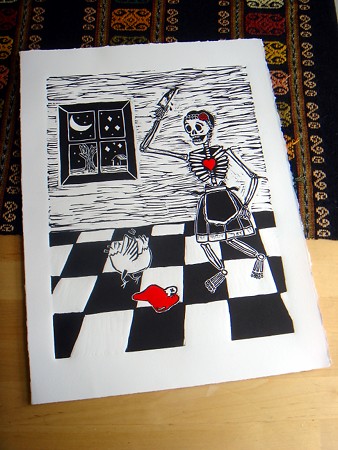
When in doubt, bake.
Actually when in doubt, cook, but for today we bake.
At the end of this semester one of my classes required a public presentation on a piece of art we created. I normally don't balk at speaking in public, but sharing anything creative I've made does tend to make me nervous. I was going to be showing a linoleum cut print I had been working on in my printmaking class, a piece that quite literally had my blood sweat and tears in it.
By some reports a bit gory, this piece to me is about the way I connect and express myself, through art and food, and also a bit about my family and a cultural heritage I claim more often than not through cooking (when you don't speak the language, food is universal). I have a fondness for my mother's stories and this reminds me of her telling me about my great-grandfather beheading chickens in their backyard.

Needing something to distract myself and hopefully distract and impress my audience if my art wasn't up to snuff, I decided a feat of baking was in order. It's a bit out of season, but Pan de Meurto, a traditional bread made for Day of the Dead, went perfectly with the theme of my art and I knew just the recipe. Guadalupe Rivera, Diego's daughter, put together a collection of Frida Kahlo's recipes. Being a great inspiration to me personally and artistically, I knew I had to use her recipe.
Now that it's done, I can't remember how the presentation went, or if the audience liked my piece, but I personally love seeing it everyday in its place honor in my kitchen, and I didn't have a single piece of bread left.
Frida's Pan de Muerte
Bread of the Dead
updated/expanded/adapted from Frida's fiestas: recipes and reminiscences of life with Frida Kahlo by Guadalupe Rivera and Marie-Pierre Colle
5 cups of flour, sifted
1 1/3 cups sugar, plus additional for dusting
2/3 cup plus 2 1/3 Tbs Butter
1 1/2 packages (3 tsp) yeast dissolved in 3 1/2 Tbs warm milk
6 large eggs (room temperature)
1 1/2 tsp ground cinnamon
1 1/2 tsp vanilla
1/3 cup milk
1) Melt butter and 1/3 cup milk on stove over medium low-heat. Allow to cool.
2) Mound the flour in the center of a large bowl and make a well. Add sugar, butter/milk mixture, yeast mixture, eggs, cinnamon, and vanilla to the well.
3) Gently work into a dough and knead until it pulls away from the side of the bowl. If it is too soft, add in more flour.
4) Shape into a ball, grease and flour lightly, and place in a greased bowl. Let stand in a warm place until doubled, about 2 1/2 hours. Cover with a towel and refrigerate overnight (at least 6-8 hours).
5) Divide the dough in half, divide each half into thirds, and each third into sixths. You should have 36 golf ball sized balls of dough. Take breaks while handling the dough and allow to rest in the fridge, it shouldn't get too warm.
6) Take one out of every 6 balls of dough (6 balls total) and reserve for decorations. For the remaining 30 balls, roll into a sphere and decorate with two small, thin, snakes of dough made to look like bones. Each of your balls of dough reserved for decoration should make 10 snakes and decorate 5 balls.
7) Place the decorated balls on a sheet of parchment, greased, on a baking sheet and let rise for a second time. Place in a warm location for about 1 1/2 hours or until the balls have doubled in bulk.
8) Sprinkle with sugar and bake in a preheated oven at 350 degrees. Each tray should take 12-15 minutes, but check as early as 10 minutes and leave in as long as 20 (checking often) in order to attain a golden color. Rotate as necessary in order to prevent over-baking. Ovens will vary. Bottoms should sound hollow when tapped.
Excellent when slightly warm and enjoyed with a cup of coffee, hot chocolate or tea.
Saturday, June 5, 2010
Pan de Muerto: Frida's Dead Bread and Blatant Bribery with Baked Goods
Subscribe to:
Post Comments (Atom)



No comments:
Post a Comment